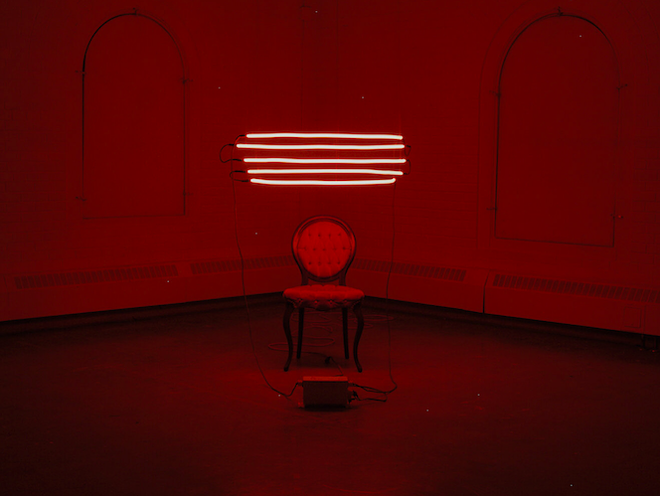Kaiser Gallery Debuts 'Lateral Perspective' Exhibition From Neon Light Artist Ethan Samaha
The show features upwards of 220,000 volts of electricity
The Kaiser Gallery today showcases "Lateral Perspective," a new exhibition of work by Ethan Samaha that alters the viewer's sense of light and space using subtle shifts in color and form.
It opens tonight from 6 to 9 p.m. as part of Walkabout Tremont.
“Approaching light as a material, instead of illumination of spaces, I’m exploring how light is traveling around the space within Kaiser Gallery,” said Samaha. “Expanding and contracting architectural details using 'color shadows.' 'Color shadows' happen with two or more different colored lights interact with an architectural element producing shadows which are than filled with the opposite color. Some designs utilize mass amounts of a singular color, engulfing the viewer’s visual space in a singular color and pushing the amount of a singular color the human eye can see. The cones in our eye will be saturated with the singular color of one piece then be over stimulated with the next color as the human eye adjusts to the different wavelengths of light.”
The light color of the works in this exhibition range in intensity from saturated to monochromic. Using ‘color shadows’ and installing his work in the open floorplan of Kaiser welcomes the viewer to interact with the pieces in a way which may intensify their interpretation of neon light design. This use of colored light and repetitive lines can amplify or subdue how these forms interact with the viewer’s psyche.
“Color plays a huge portion in my work. Sometimes I will design an entire piece around one color,” said Samaha. “What’s interesting with neon/light as a material is the use of both the standard color wheel and the light color wheel. The primary colors being, red, yellow, blue. Where the light color wheel is red, green, and blue. If you mix red, blue, and yellow paint together you would get brown. When you mix red, green, and blue light together, you get white light. I’m also thinking about the frequency of each color on the spectrum. I sometimes approach color and light from a theatrical way of thinking. Attaching emotion/ feelings with certain colors and intensity. Other times I just like to bask in rich, saturated, solid colored light and want to share that experience with viewers.”
In an example of Samaha’s work, “Obscure Sense x3,” five streams of neon light of varying lengths are suspended above an antique chair creating an otherworldly effect. The piece offers a sense of futuristic nostalgia where one can’t avoid thinking of the film Blade Runner. The neon design interacts with the relic seat causing a tension between time and space.
To heighten the eeriness created by this contrast, the sculpture seems to hover, un-tethered above the chair as if some mystical force or the electricity itself elevates the piece. A visual anxiety manifests, probing the viewer to consider: what if the fragile glass construction was to somehow come crashing down from loss of electrified current.
The process of neon light construction consists of brightly glowing, electrified glass tubes or bulbs that contain rarefied neon or other gases which were sealed in a glass tube and sealed with a metal electrode at each end. These lighted tubes were popularized in advertising in the 1930s, then for some time waned in popularity until the 1980s where neon again found its way into to popular culture and fine art.
The Museum of Neon Art, founded by neon artist, Lili Lakich, Los Angeles, opened in 1981. The glow and intensity of these bright colors always seem engross and fascinate especially in American popular culture. The process of creating these glowing, colorful bulbs with their pulsing light waves conjures a sense of nostalgia and curiosity.
“Once all the colors are picked, I start the bending process,” said Samaha. “All glass tubing comes in either 4 or 5-foot length of straight glass. I bend the glass over specialty neon torches. Once all glass is bent, the tubes are then hooked up to a manifold which sucks all the air out and allows Nobel gasses to be backfilled into the tube. The tubing is then heated from the inside out using a large amount of electricity to clean and sterilize the tube. After the tube is sterilized, noble gasses can be backfilled into the tube. The gasses are then getting trapped inside by sealing one end of the tube. The filled tube then gets hooked up to a transformer, which produces high voltage ranging from 5,000-15,000 volts of electricity. The high voltage sparks the Nobel gas and illuminates the gas producing color light. Colored light that can be filtered through phosphors and/ or colored glass tubing to produce a wide array of colors.”
Currently based in, Lovettsville, Virginia, the 23-year-old received a BFA in sculpture and dimensional studies from the New York State College of Ceramics at Alfred University in 2021. Samaha also minored in Performance Design & Technology, and maybe this is why theatrical stage lighting used for dramatic effect has influenced this current body of work.
Samaha says that he is thinking about the frequencies of the colors on the spectrum and that he does sometimes approach color and light from a theatrical perspective, attaching emotion and intensity to certain colors for a vivid effect on the viewer sometimes basking in rich, saturated, solid color.
Samaha will be in attendance for the opening reception and wants viewers to know that the show features upwards of 220,000 volts of electricity.
Coming soon: Cleveland Scene Daily newsletter. We’ll send you a handful of interesting Cleveland stories every morning. Subscribe now to not miss a thing.
Follow us: Google News | NewsBreak | Instagram | Facebook | Twitter


